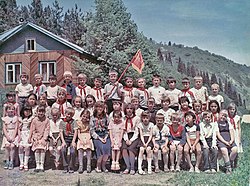Pioneer movement
Pioneer movements are movements for children and adolescents. They were founded in countries where there is a Communist party. Many of the ideas are taken from the scout movement. In most communist countries, people can choose if they want to be members of the pioneer movement or not. There are many differences between a pioneer movement, and the scout movement. Scout movements are independent of governments. They are also not controlled by the state. For example, there were no separate organizations for boys and girls. During the time of the USSR, thousands of Young Pioneer camps and Young Pioneer Palaces were built. These could only be used by Young Pioneers. The camps and palaces were also free of charge, it did not cost any money to use them. The government and trade unions sponsored them. There were many newspapers and magazines published for Young Pioneers. Some sold millions of copies.
Certain features, however, are similar to the Scout movement. The two movements share some principles like preparedness and promotion of sports and outdoor skills. The pioneer movement also includes teaching of communist principles. Opponents of Communist states claim that this is a form of indoctrination.
A member of the movement is known as a pioneer, and a scarf – typically red, but sometimes light blue – is the traditional item of clothing worn by a pioneer. The pioneer organization is often named after a famous party member that is considered a suitable role model for young communists.
In the USSR it was Lenin; in East Germany, it was Ernst Thälmann. The Thälmann pioneers were taught the slogan "Ernst Thälmann is my role model. We wear our red scarf with pride."Albania, which had severed diplomatic relations with the USSR since 1961, also had a certain variant of Pioneer organization, called Pioneers of Enver, named after the communist ruler of Albania, Enver Hoxha.
Today, the following countries have pioneer movements:
- Belarus (Belarusian Republican Pioneer Organization)
- Belgium (Pioneers of the Workers Party of Belgium)
- People's Republic of China (Young Pioneers of China)
- Cuba (José Martí Pioneer Organization) Established in 1961; in 2001 it was elected to the Global 500 Roll of Honour of the United Nations Environment Programme for its environmental activities.[1]
- Cyprus (EDON)
- Finland (Democratic Union of Finnish Pioneers)
- The Czech Republic – Nowadays Pionýr is a non-political organization organizing leisure time for children, part of the IFM-SEI.
- North Korea (Young Pioneer Corps)
- Russia
- Spain (Pioneers of the Communist Party of the Basque Homelands)
- Tajikistan (King Somoni Inheritance)
- Syria (Baath Party Pioneers)
- Vietnam (Ho Chi Minh Young Pioneers, established on May 15, 1941[2])
Older children could continue in other communist organizations, but that would typically be done only by a limited number of people.
Pioneer Movement Media
Young Pioneers at a Young Pioneer camp in Kazakh SSR.
Emblem of the Soviet Pioneer Organization with a silhouette of Vladimir Lenin and the inscription Always prepared!
Emblem of the Korean Children's Union
Emblem of the Union of Pioneers of Yugoslavia
Emblem of the Dimitrovist Pioneer Organization "Septemberists"
Related pages
References
- ↑ "THE JOSE MARTI PIONEER ORGANIZATION OF CUBA, ONE OF 18 INDIVIDUALS AND ORGANIZATIONS, TO RECEIVE UNITED NATIONS ENVIRONMENT AWARD". United Nations Environment Programme. Archived from the original on January 13, 2013. Retrieved June 29, 2006.
- ↑ "Young Pioneers honoured on Brigade's 65th anniversary". Vietnam News Agency. Archived from the original on August 10, 2007. Retrieved June 29, 2006.
Other websites
| Wikimedia Commons has media related to Lua error in Module:Commons_link at line 62: attempt to index field 'wikibase' (a nil value).. |
- Pioneers (Belgium) Archived 2007-09-28 at the Wayback Machine
- Rules of Thälmann Pioneers (GDR) Archived 2010-06-04 at the Wayback Machine
- Young Pioneers (People's Republic of China)
- Ho Chi Minh Communist Youth Union (Vietnam) Archived 2007-10-30 at the Wayback Machine






